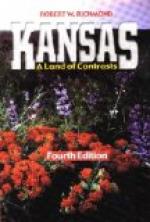It is, perhaps, worth noting that the comfort of the engine-driver, or engineer as he is called lingua Americana, is much better catered for in the United States than in England. His cab is protected both overhead and at the sides, while his bull’s-eye window permits him to look ahead without receiving the wind, dust, and snow in his eyes. The curious English conservatism which, apparently, believes that a driver will do his work better because exposed to almost the full violence of the elements always excites a very natural surprise in the American visitor to our shores.
The speed of American trains is as a rule slower than that of English ones, though there are some brilliant exceptions to this rule. I never remember dawdling along in so slow and apparently purposeless a manner as in crossing the arid deserts of Arizona—unless, indeed, it was in travelling by the Manchester and Milford line in Wales. The train on the branch between Raymond (a starting-point for the Yosemite) and the main line went so cannily that the engine-driver (an excellent marksman) shot rabbits from the engine, while the fireman jumped down, picked them up, and clambered on again at the end of the train. The only time the train had to be stopped for him was when the engineer had a successful right and left, the victims of which expired at some distance from each other. It should be said that there was absolutely no reason to hurry on this trip, as we had “lashins” of time to spare for our connection at the junction, and the passengers were all much interested in the sport.
At the other end of the scale are the trains which run from New York to Philadelphia (90 miles) in two hours, the train of the Reading Railway that makes the run of 55 miles from Camden to Atlantic City in 52 minutes, and the Empire State Express which runs from New York to Buffalo (436-1/2 miles) at the rate of over 50 miles an hour, including stops. These, however, are exceptional, and the traveller may find that trains known as the “Greased Lightning,” “Cannon Ball,” or “G-Whizz” do not exceed (if they even attain) 40 miles an hour. The possibility of speed on an American railway is shown by the record run of 436-1/2 miles in 6-3/4 hours, made on the New York Central Railroad in 1895 (= 64.22 miles per hour, exclusive of stops), and by the run of 148.8 miles in 137 minutes, made on the same railway in 1897. The longest unbroken runs of regular trains are one of 146 miles on the Chicago Limited train on the Pennsylvania route, and one of 143 miles by the New York Central Railway running up the Hudson to Albany. As experts will at once recognise, these are feats which compare well with anything done on this side of the Atlantic.




